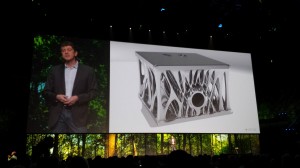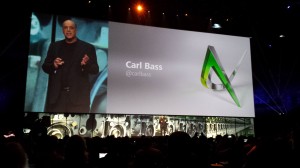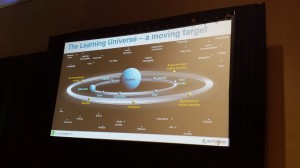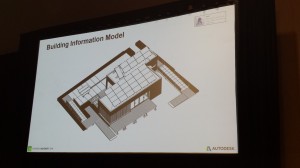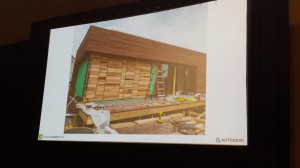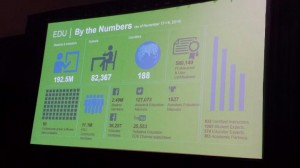The arena was packed. Wall to wall people. Everyone rushing around trying to find a seat.
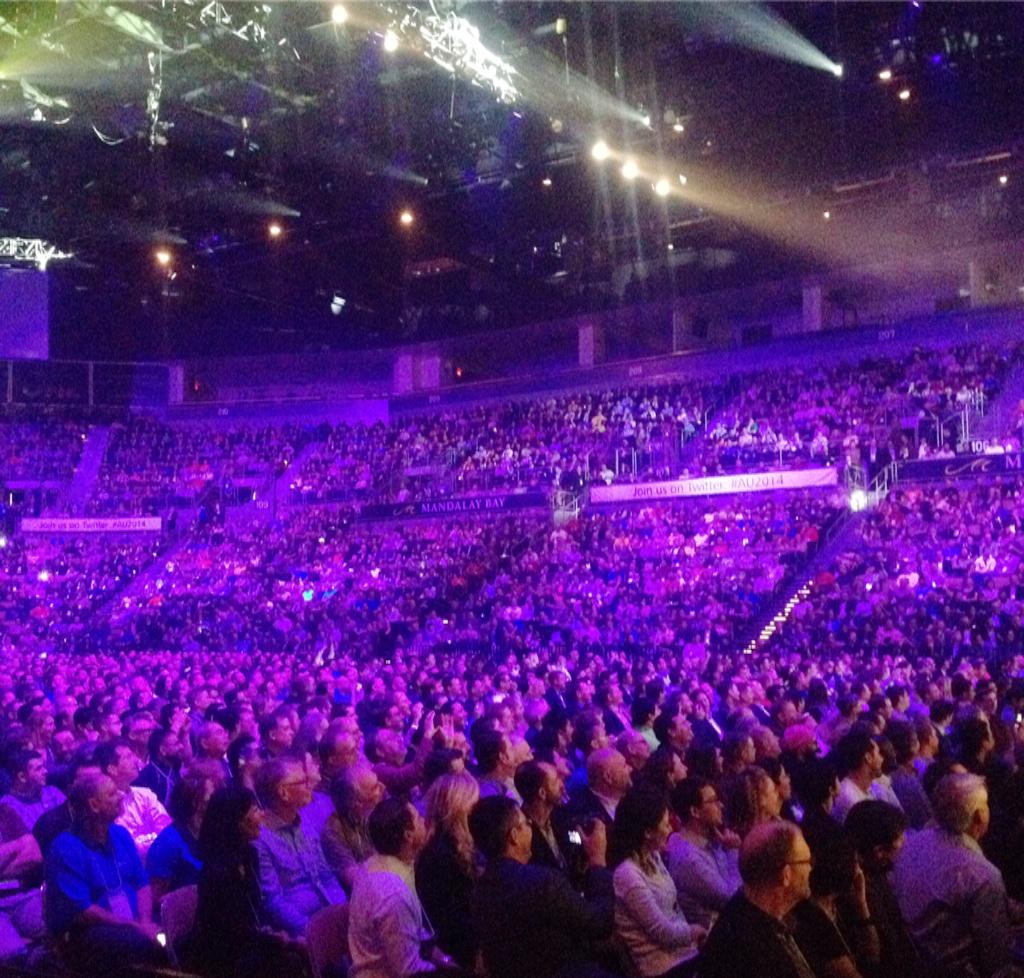
Lynn Allen opened the keynote followed by a Back to the Future skit and 20 gun t-shirt launcher that shot shirts across the entire arena.
Jeff Kowalski, CTO at Autodesk, discussed how nature produces design. He says that we need to stop thinking of our computers as drawing tools, start thinking of them as design tool. He went on to say that today computers are able to design in ways that humans cannot. Generative design allows us to define the outcome and let the computer generate the design.
Designers need to ask… How could generative design help solve your problems? Could you actually add “life” to it? or “What if your competitors introduce a product that has life in it?
Carl Bass came on stage to rousing applause. In his usual casual manner, he started discussing how interactions with computers and design have changed. We use to interact with computers using just a keyboard and mouse. We now use point clouds. He then unveiled amazing point clouds and their uses.
Announcements at the event included:
- Access to A360 for a free year for AU attendees
- A new subscription model where for one fee (not defined) you get access to all Autodesk products
- Access to educational software… Any Student, Any Teacher, Any Institution, Anywhere
Carl Bass yielded the stage to Emily Pilloton Project H – housing for the needy and a farmers market design and construction project run by 16 yr old students. See a Ted Talk by her.
After fighting through the massive crowd, I made it to the AUGI Volunteer lunch and chatting with my AUGI buddies. I look forward to the AUGI Annual Meeting on Wednesday.
My focus this year is education. Last year I attended many of the ADN classes… This year it is training and education. The first presentation of my day was on project based learning. They covered how to achieve maximum learning through focused project efforts. The goal for the student is not to be taught by an instructor, but rather to get the project completed. Along the road, learning is taking place. Teachers must leave behind former approaches to teaching. Allowing students to learn without the teacher being the focus of the learning. The project is the focus. There may not be an answer when you begin the process. The students discover the answers as they move along. The teacher may direct or suggest the next steps, but they let the student move on their own.
More on this at their next presentation – digital steam project – Thursday at 8am
Day two will wrap up with the Exhibit Hall opening – I can’t wait for that!!
The first day started off with the Education Keynote. Chris Bradshaw of Autodesk hosted the event. So much good information at the event. See images below for some of the slide deck.
This is the Learning Universe – what tools we have to learn from.
This image and the one below were from a sustainable design educational contest where students used Revit tools to design a green building.
And the Autodesk Educational Community – by the numbers
I then attended the Freshman Orientation hosted by Lynn Allen. She informed a packed house of new attendees on the highlights to not miss for the week. She discussed the AU2014 App that everyone is using. It is packed full of info. Even if you are not attending, you can follow the stream of info and tap into many items.
One tool in the App is the Survey tools that she used throughout the presentation. Quick surveys that displayed the results on screen as they were happening.
At the Freshman event, I met three design professionals for Turkey – Tunc, Onur and Erkan. They work at Dome + Partners, a design firm located in Istanbul, Turkey. They do mixed use, theme parks, high rise and much more. This was their first AU… Check out their designs at http://www.dome.ws. I also met Jeffrey Muhammad, a Professor at Austin Community College. He is teaching Civil3D to students in Texas.
Innovation Forums were mentioned as the focus of the major presentations from Autodesk. AUGI was mentioned as a premiere community for networking after the event. Lynn also discussed the Answer bar, Meetup lounges and more.
Certification exams are being offered for free and there was a really long line already. Many taking the opportunity to test their skills and gain a certification that can be added to their resume.
Autodesk also discussed the Voice of the Customer. They are testing out new designs and feature, sneak peeks, and they want to listen to your input. Round tables and interviews are being scheduled so that Autodesk can get direct input from uses. Check the schedule to see how you might get involved.
So many ways to connect. So many ways to learn. This is promising to be a great event again this year.
I ended the night at a Media Reception where I discussed Revit and other BIM tools with Scott Latch, the Building Platform Product Manager. He said that the Revit team is still striving for new goals in the tools we all use. He outlined one – Skyscraper – that is available as a Revit collaboration toll. You can read more here. It is a cloud tool that has many features for scattered teams and partners. Look for more on this from Autodesk at this conference.
Well – tomorrow is looking to be very crowded. I hope to see some of you and to keep the rest informed via my posts. Follow me on Twitter for news as the day progresses.
As I watch the Twitter feeds and Facebook posts, it is apparent that many have started the annual trek to the dessert. Flying, driving and taking trains, maybe some even walk. But one thing is obvious, this is THE EVENT to attend for anyone that uses Autodesk products. It is where you can network, connected, discuss and even argue about the good and bad of the software that drives us all forward. It is the time when enabling Design, Manufacturing, Infrastructure and Entertainment is the main focus with a heavy dash of Education mixed through it all.
The Future… this is the thread that weaves through the fabric of the event. Carl Bass, CEO, will kick it off with Jeff Kowalksi, CTO at the opening keynote – The Future of Making Things. Several other Forums focus on the Future of… How Buildings are Made, How Products are Made, How Infrastructure is Made and How Visualizations are Made.
With these focused topics, almost 800 classes and close to 200 exhibitors, there will be no lack of learning. And education is what this whole event is about. Autodesk has gathered about 825 speakers who are the cream of the crop. Some of the best from past events and some great newcomers. Soak it all in.
And after you have soaked it in – get Certified – its free. User Certified, Certified Professional and Certified BIM Specialist. You can tap into this free offer at multiple times during the week.
So much going on – so little time. See you soon.
1. I get to see/network with all of my peers. I think this is the first thing that I love about AU. It gives me a chance to interact and catch up with all those that I have connected with in the past. It gives me a chance to connect with new people. I seriously set out to talk to more strangers in one week than I do for the rest of the year.
2. Checking out new technology. I love seeing what the mature tools have added and what new tools are being introduced. I walk the show floor to take it all in. I stop at every booth that grabs my attention. What grabs my attention? It is great new ideas that are innovative and/or iterative. It is the big leaps in technology and the small steps that eliminate pains that I have.
3. Finding out what Autodesk is up to. I love listening to what they have to tell me. I do not take it all at face value. I dig into what they say and see what practical value it will have for me. It is the real productivity and creativity innovations that launch my imagination about how their tools might change my firms workflow and output.
4. Listening to great speakers. Every speaker has some key point that will unlock the chains of my technologies shackles. These experts will help release me from the fetters that bind my ability to get things done. These speakers provide me with so many tips and tricks and new perspectives that my head aches by the end of each day.
5. Finding out how AUGI is expanding. Every year the membership climbs, the forums expand, publications flourish and the benefits of membership go up. I am hoping for great things this year.
6. Presenting. I love to present and I hope that I am effective and enjoyable to listen to. I seek to make you think, change your perspective, widen your view, focus your planning, execute with vigor and increase the joy of working with CAD/BIM and the people who you manage and work with.
7. And finally, I love to introduce others to the things I love. If you meet up with me, you can expect me to share something with you that you need to tap into. I will introduce you to others that I think you should get to know. I will ask if you have been to a vendors booth to see the great tech there. I will encourage you to talk to the teachers, Autodesk staff and vendors so that you will come to love AU like I do.
If you are able to go this year… See you soon.
There are several things that most users want from a CAD Manager. Of course they want the latest and greatest hardware and software. And they want killer training. But I want to go beyond the obvious to what I think are some pivotal items that Here is my list of the things that they want that make the biggest impact on the company and their environment.
Leadership
All users and firms want someone who will take charge of the CAD environment and make progress toward some goal. The goals may differ from firm to firm but they must align with the firm and user needs. Leadership includes laying out a plan and moving decisively to achieve the goals.
Honesty
No one likes to be lied too. I am not talking about bold face lying. I trust that no one really does that. But Users will be sensitive to the information or lack of info that comes from the CAD Manager. They want honest answers that don’t duck the questions. They want honest responses that address the problems. They need you to be direct and to the point (in a respective manner).
Ownership
They want you to take ownership of everything that gives them problems. They want to pass their problems on to you. They want you to fix them and get everything back on track. CAD Managers that refuse to “own” their systems only create more problems. Every problem that occurs in your office related to CAD is really “your” problem. If it is not a work stopper, then take on the problem and let them keep working. Get back to them with the fix ASAP.
Troubleshooting skills
They want you to know how to diagnose and fix troubles. They want you to analyze and work toward a fix. Reduce the problems to their root cause and then evaluate corrective actions or workarounds. What they really need is for you to get them back to being productive as soon as possible.
Attention
They want you to pay attention. They may not say it but they want you to be attentive to what they complain about and seek to alleviate those annoyances.
They want you to do this before they ask. So listen to what they are saying and what they mention that sounds like it may soon be a problem. Keep a sharp eye out for telltale signs of frustration. Ask them what is going wrong. In fact, don’t even wait for signals, just ask them from time to time what is not working.
Progress
They want to see progress on issues. They don’t necessarily need to see instant results, but they need to see things progressing along. If you say that you will be updating the layer list, then make it happen. If you are not going to focus on something, don’t make any promises that you will. (kind of goes back to the honesty thing)
Left alone
Sometimes the users just want to be left alone. The pace of software upgrades and changes in the CAD arena demand a lot of learning and effort on the part of your users. You need to give them a respite from the fast paced world of CAD releases.
A partner
They want to feel like you are on the same team. I have heard stories from users that their CAD Managers treat them like inferiors or kids or losers. This is obviously not a good situation for happy users. They would rather work in an environment where communication flows freely and openly. Where you keep them involved and informed. They would rather work where it is a collective team working toward a common goal.
Integrity
This is the glue that holds the whole thing together. It means doing what you say you are going to do. Taking responsibility for issues and working together to make your CAD environment a successful one.
I attended a webinar today on the 2015 Autodesk Application Manager presented by Erik Klein. It seemed pretty promising for the SMB sized firms.
Autodesk defines this new tools as :
Autodesk Application Manager is a cloud-centric software delivery solution, which includes a desktop software component that self-installs with all Microsoft Windows®-based Autodesk 2015 products and suites. This solution replaces previous product update components, specifically LiveUpdate, portions of InfoCenter / Communication Center, and CAD Manager Control Utility (note that these components will remain in production to support previous product versions).
What it does is assist in the management of your installed versions of your licensed products under subscription. There is an installed client that gets put in place with the install of 2015 products (this can be turned off). Once installed the CAD Manager can create lists of users on the Account Portal and manage notifications and distributions of software upgrade, patches and hot fixes.
To find out more go to the Knowledgebase FAQ
I ended the last series on Critical Conversations about CAD with some quick advice on what to do when you fail. I wanted to revisit that topic and provide some additional comments on learning from failure. When failure happens you have to review how you got in that position. How could things have gone so bad? What can we do to avoid this from happening again?
Reevaluate what really happened. Do not just take the surface and obvious items that everyone can see. Look deeper. The obvious things might be key to finding root causes, but some things might lay just under the surface. Uncover more than you may have done in the past. Review the obvious and peel back each step to see if the failure was a gradual decline or a sudden fall. Did each step work as expected? Did the result of each step completely meet expectations? If not – Why not? You have to keep asking “why?” Why did this happen? Why did we not see this? Why did it not work?
Rethink what you might have done. What might you have done at each step that would have improved the outcome? If we applied more resources, what would have happened? If we had more budget would it really have mattered? Throwing money at a problem does not guarantee success. If we had another team member in the mix we could we have made better progress?
Get input from others. Specifically, someone that was not involved with the planning and execution. Some items may be obvious to others and seem hidden from your sight. Others may see it immediately while you may have to look beyond your preconceived perspectives.
Think about what you will do differently next time – then actually do it. Do not only devise or speculate on what you might change in the future… actually change something. Doing things the same way and expecting things to come out differently is pure folly. Manage the change so that you know that what was changed actually impacted the outcome. Too often we change too many things at the same time and never discover which ones had the greatest effect.
Don’t do nothing. Doing nothing only permits anyone to grab at what might have caused the failure and what might turn it into success. There is an inability built into each one of us to see beyond our immediate perception. We need to see beyond our original planning and seek to do better next time through specific modifications in our approach.
Don’t come to a conclusion too quickly. Some may ask “how long do we analyze this failure before we move on?” You should ponder your failures as long as it takes. Seem subjective? it is. Do not move forward until you have at least three actionable reasons for the failure. Don’t move after the first one you find. Don’t move on until you have specific actionable items to work on. Straining to find more than three can stagnate and frustrate. Three items seems like a good start.
CAD Issues that are brought to you must be addressed. CAD problems can corrupt CAD files, cripple progress and ruin projects. This is not a good thing. Issues have to be dealt with when they arise. Better yet – tackle them when they are just concerns before they become failures.
But failures happen. They are often avoidable when issues are caught early and addressed, but can still happen even when you know they are coming. I have seen train wreck projects that continue to cascade down the line toward failure. I have seen countless man-hours chewed up fixing things that were left in a mess. I have seen users do very interesting things that mangle files.
When an issue goes unaddressed it breed failure. Things break and may become irreparable. Then you have to recreate things to get them working. CAD failures impact you as the CAD Manager. They reflect badly on your ability to keep things running smoothly. They may not be something that you could have prevented, but others think you can.
When CAD Failures Happen
Take ownership of the repair. Do whatever you can to get things back on track. Personally take charge of the situation and make adjustments and suggestions as needed.
Speak the truth. Don’t candy coat things. Tell people what the problem is and what you think the fix is. Don’t place blame, but do not let blame land on your shoulders if it is not warranted. Others will try to place it firmly in your hands, so document your findings and tell people what really might have cause the problem. Keep it positive and not a negative attack on anyone, but get your perspective out there.
Address the issues directly with management. Take the conversation as high up the food chain as you can take it. As you move higher, keep the conversation brief unless they ask more questions. Most upper managers do not want a forensic investigation outlined to them in detail. They want a concise explanation of the problem and a definitive plan to correct it.
Follow through on the repairs. If you are doing them, let people know when they are done. If others are doing them, check in often for updates and examine the results to verify that the fix really worked.
You notice something. Then you become concerned. Then it becomes an “Issue”. That is the progression… but how does it move from one to the next?
These are the steps of items evolving beyond annoyance, anomaly or abstraction. These are the items that have others moving beyond concern to very concerned, to an issue. The conversations that others start with you begins with “We have an issue with…” and move quickly from there to possibly even more advanced levels.
How things move from Noticed to a Concern
If you notice something, you keep your eye on it and address it when it first looks to be a concern. Others typically do not bring you things that they notice. They may mention them in conversation, but it is typically not the topic of the discussion. they may concur when you mention something. They may validate your perceptions, but they seldom bring things up that they have noticed.
After investigating things you notice, if they are bigger than you think or have greater impact, they move to concerns. You can move them ahead on this progression of awareness. When things that you notice move to things that cause concern, that is when you go talk to others. It has moved from being noticed and is now a concern.
But when do people come and talk to you about troubling items? People mostly bring things to your attention when they have moved from being noticed to being a concern. This is when you hear about things that you have not noticed. It happens when it becomes a concern to someone else. They come and talk to you about it. This is the same progression that happened like your own advancement from noting to concern. The awareness just happened to someone else.
How things move from Concern to Issue
Moving from concern to issue happens when something along the pathway of correction fails to work. It happens when corrective measures are not started. There are a few ways that this happens.
Things get to the issue level by being ignored. Face it, sometimes things just fall through the cracks. They get pushed to the back of the list when they should have been “noticed” and move to the front. They get bumped behind something that seemed more urgent when they should have been seen as a “concern”. They should have been fixed sooner than this.
Things get to an issue level when you are not made aware of them. You may not even know that people have noticed some area of trouble, or when they have identified it as a concern. They come to you when they are already broken. No one makes you aware of the concern until it is too late for you to head off the problem.
Things get to an issue level when your corrective measures are not enough. You may have seen it coming and started repairing the files or projects effected, but it is not enough to get out ahead of the problem. The impact has started and you are not able to contain the effects.
Next up… When Issues Descend into Failure
